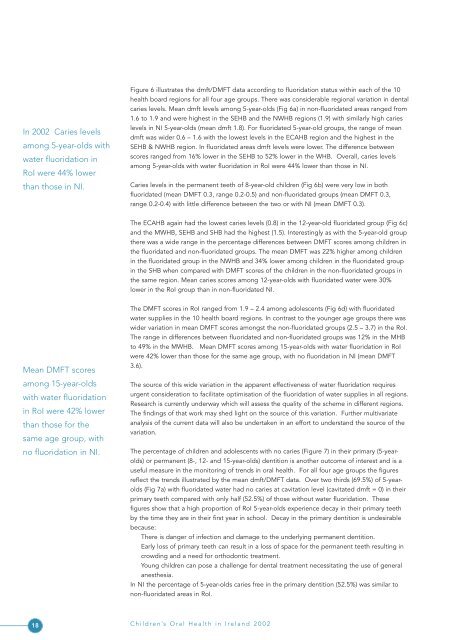Oral Health inside - Communities and Local Government
Oral Health inside - Communities and Local Government
Oral Health inside - Communities and Local Government
Create successful ePaper yourself
Turn your PDF publications into a flip-book with our unique Google optimized e-Paper software.
In 2002 Caries levelsamong 5-year-olds withwater fluoridation inRoI were 44% lowerthan those in NI.Figure 6 illustrates the dmft/DMFT data according to fluoridation status within each of the 10health board regions for all four age groups. There was considerable regional variation in dentalcaries levels. Mean dmft levels among 5-year-olds (Fig 6a) in non-fluoridated areas ranged from1.6 to 1.9 <strong>and</strong> were highest in the SEHB <strong>and</strong> the NWHB regions (1.9) with similarly high carieslevels in NI 5-year-olds (mean dmft 1.8). For fluoridated 5-year-old groups, the range of me<strong>and</strong>mft was wider 0.6 – 1.6 with the lowest levels in the ECAHB region <strong>and</strong> the highest in theSEHB & NWHB region. In fluoridated areas dmft levels were lower. The difference betweenscores ranged from 16% lower in the SEHB to 52% lower in the WHB. Overall, caries levelsamong 5-year-olds with water fluoridation in RoI were 44% lower than those in NI.Caries levels in the permanent teeth of 8-year-old children (Fig 6b) were very low in bothfluoridated (mean DMFT 0.3, range 0.2-0.5) <strong>and</strong> non-fluoridated groups (mean DMFT 0.3,range 0.2-0.4) with little difference between the two or with NI (mean DMFT 0.3).The ECAHB again had the lowest caries levels (0.8) in the 12-year-old fluoridated group (Fig 6c)<strong>and</strong> the MWHB, SEHB <strong>and</strong> SHB had the highest (1.5). Interestingly as with the 5-year-old groupthere was a wide range in the percentage differences between DMFT scores among children inthe fluoridated <strong>and</strong> non-fluoridated groups. The mean DMFT was 22% higher among childrenin the fluoridated group in the NWHB <strong>and</strong> 34% lower among children in the fluoridated groupin the SHB when compared with DMFT scores of the children in the non-fluoridated groups inthe same region. Mean caries scores among 12-year-olds with fluoridated water were 30%lower in the RoI group than in non-fluoridated NI.Mean DMFT scoresamong 15-year-oldswith water fluoridationin RoI were 42% lowerthan those for thesame age group, withno fluoridation in NI.The DMFT scores in RoI ranged from 1.9 – 2.4 among adolescents (Fig 6d) with fluoridatedwater supplies in the 10 health board regions. In contrast to the younger age groups there waswider variation in mean DMFT scores amongst the non-fluoridated groups (2.5 – 3.7) in the RoI.The range in differences between fluoridated <strong>and</strong> non-fluoridated groups was 12% in the MHBto 49% in the MWHB. Mean DMFT scores among 15-year-olds with water fluoridation in RoIwere 42% lower than those for the same age group, with no fluoridation in NI (mean DMFT3.6).The source of this wide variation in the apparent effectiveness of water fluoridation requiresurgent consideration to facilitate optimisation of the fluoridation of water supplies in all regions.Research is currently underway which will assess the quality of the scheme in different regions.The findings of that work may shed light on the source of this variation. Further multivariateanalysis of the current data will also be undertaken in an effort to underst<strong>and</strong> the source of thevariation.The percentage of children <strong>and</strong> adolescents with no caries (Figure 7) in their primary (5-yearolds)or permanent (8-, 12- <strong>and</strong> 15-year-olds) dentition is another outcome of interest <strong>and</strong> is auseful measure in the monitoring of trends in oral health. For all four age groups the figuresreflect the trends illustrated by the mean dmft/DMFT data. Over two thirds (69.5%) of 5-yearolds(Fig 7a) with fluoridated water had no caries at cavitation level (cavitated dmft = 0) in theirprimary teeth compared with only half (52.5%) of those without water fluoridation. Thesefigures show that a high proportion of RoI 5-year-olds experience decay in their primary teethby the time they are in their first year in school. Decay in the primary dentition is undesirablebecause:There is danger of infection <strong>and</strong> damage to the underlying permanent dentition.Early loss of primary teeth can result in a loss of space for the permanent teeth resulting incrowding <strong>and</strong> a need for orthodontic treatment.Young children can pose a challenge for dental treatment necessitating the use of generalanesthesia.In NI the percentage of 5-year-olds caries free in the primary dentition (52.5%) was similar tonon-fluoridated areas in RoI.18 Children’s <strong>Oral</strong> <strong>Health</strong> in Irel<strong>and</strong> 2002
















